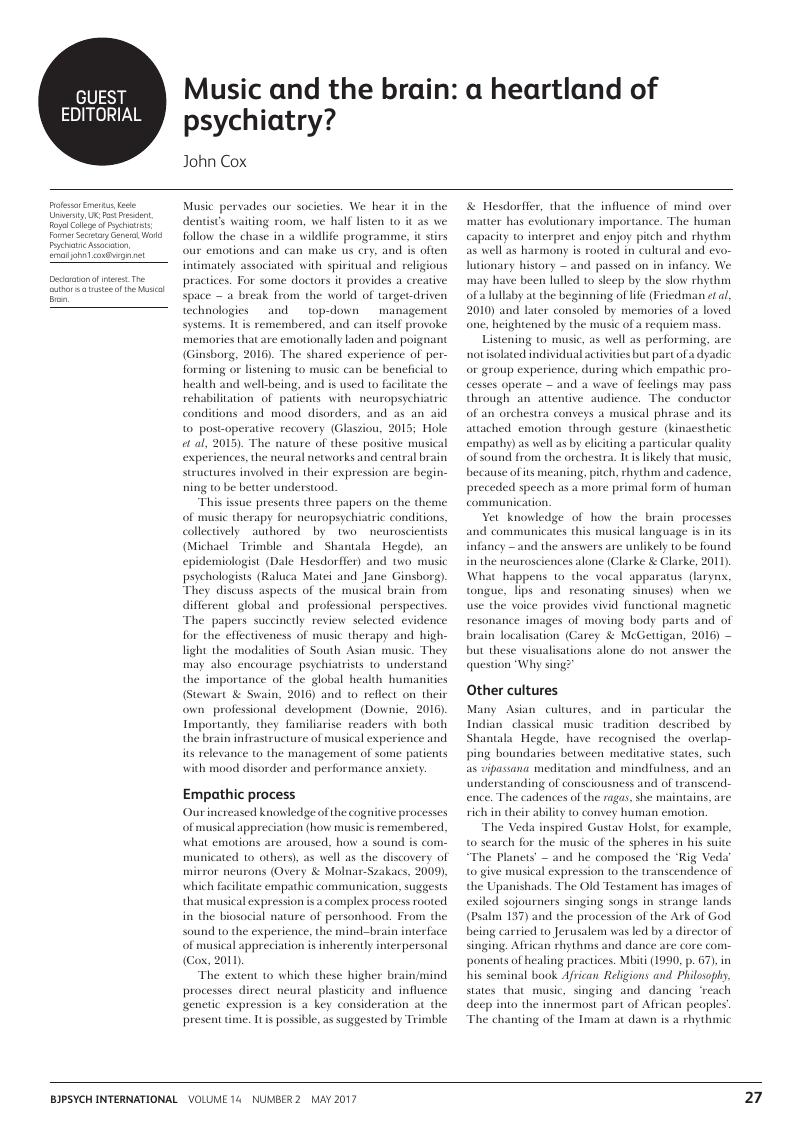No CrossRef data available.
Article contents
Music and the brain: A heartland of psychiatry?
Published online by Cambridge University Press: 02 January 2018
Abstract
An abstract is not available for this content so a preview has been provided. As you have access to this content, a full PDF is available via the ‘Save PDF’ action button.

- Type
- Guest Editorial
- Information
- Creative Commons
- This is an Open Access article, distributed under the terms of the Creative Commons Attribution-NonCommercial-NoDerivatives licence (http://creativecommons.org/licenses/by-nc-nd/4.0/), which permits noncommercial re-use, distribution, and reproduction in any medium, provided the original work is unaltered and is properly cited. The written permission of Cambridge University Press must be obtained for commercial re-use or in order to create a derivative work.
- Copyright
- Copyright © Royal College of Psychiatrists, 2017
References
Carey, D. & McGettigan, C. (2016) Magnetic resonance imaging of the brain and vocal tract. Applications to the study of speech production and language learning. Neuropsychologia. https://doi.org/10.1016/j.neuropsychologia.2016.06.003. [Epub ahead of print]Google Scholar
Clarke, D. & Clarke, E. (eds) (2011) Music and Consciousness: Philosophical, Psychological, and Cultural Perspectives. Oxford University Press.CrossRefGoogle Scholar
Cox, J. L. (2011) Empathy, the song and the singer: the legacy of Robert Schumann. Advances in Psychiatric Treatment, 17, 447–458.CrossRefGoogle Scholar
Downie, R. (2016) Medical humanities. Journal of the Royal College of Physicians of Edinburgh, 46, 288–294.Google Scholar
Friedman, S. H., Kaplan, R. S., Rosenthal, M. B., et al (2010) Music therapy in perinatal psychiatry: use of lullabies for pregnant and postpartum women with mental illness. Music and Medicine, 2, 219–225.Google Scholar
Ginsborg, J. (2016) Memory in music hearing, listening and performance. In Performing the Remembered Present: The Cognition of Memory in Dance Theatre and Music (ed. Hansen, P.), ch. 7. Methuen.Google Scholar
Hole, J., Hirsch, M., Ball, E., et al (2015) Music as an aid for postoperative recovery in adults: systematic review and meta-analysis. Lancet, 386, 1659–1671.Google Scholar
Overy, K. & Molnar-Szakacs, I. (2009) Being together in time: musical experience and the mirror neuron system. Music Perception, 26, 489–504.Google Scholar
Rollin, H. (1998) Pioneers of music therapy. Journal of Medical Biography, 6, 160–165.Google Scholar
Stewart, K. A. & Swain, K. K. (2016) Global health humanities: defining an emerging field.
Lancet, 388, 2586–2587.Google Scholar



eLetters
No eLetters have been published for this article.